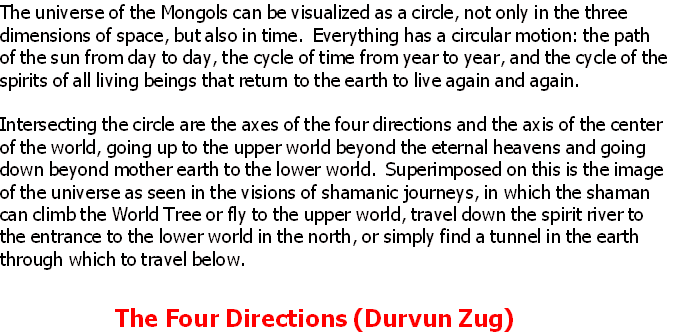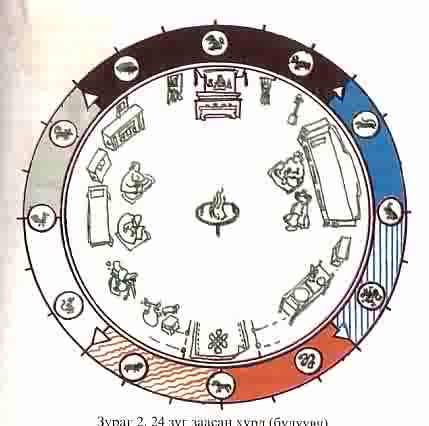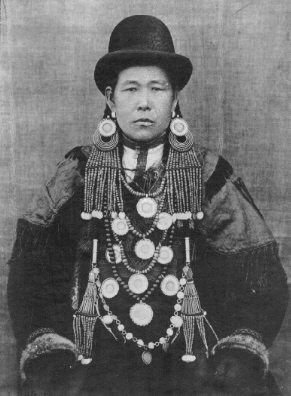|
Mongolian Cosmology |
|||||||||
 |
|||||||||
|
Awareness of the four directions is fundamental to the Mongolian view of the world. A few Mongolian friends have told me that if they are not aware of their orientation to the four directions at all times, they feel ill at ease. The names of the four directions correspond to the words for “front”, “back”, “left”, and “right”. Until about 600 or 700 years ago, the “front” orientation of the Mongol’s world was to the east, but for some unknown reason it shifted to the south, where it remains today. Many Siberian tribes still orient their dwellings to face east. |
|||||||||
|
The Ger and the Sacred Circle |
|||||||||
|
The ger, known in the West as the yurt, is the traditional dwelling of the Mongols. It is constructed of a framework of poles (uni) radiating from a center smoke-hole ring (tono), which is lashed to the top of a circular latticework wall. The structure is covered over with felt in Mongolia, although the gers of some Siberian groups are covered with skins. In Buryatia and in some other areas, an eight-sided wooden ger is made of logs with wood laid over the roof instead of felt. It bears a very strong resemblance to the hogan of the Navajo of the American Southwest. Also, many Siberian peoples, including the Tsatang and Urianhai Mongols, live in teepees. Gers and teepees (uurts) are designed to be easily assembled and taken down as required by the nomadic life of their owners; nevertheless, the imagery and meaning of the ger remain the same no matter where it is erected, and the orientation and symbolism of the ger is the same for all Mongolian groups. |
|||||||||
|
The center of the ger is the most sacred place of all, the gal golomt, or place of the fire. It is the dwelling place of the daughter of Father Heaven, Golomt Eej, and is to be treated with the utmost respect. As the ger is the center of the world, so the place of the fire is the center of the universe represented by the ger itself. The vertical axis represented by the column of smoke rising from the gal golomt also represents the turge or World Tree that shamans ascend to the upper world, with the smoke ring (tono) corresponding to the gateway to the upper world. In some shamanic rituals, such as the initiation of shamans in Buryatia, a tree will actually be erected inside the ger, beside the gal golomt and passing through the smoke hole. Among some Mongolian groups, such as the Buryats, the shaman literally climbs the tree; in others, such as the Dagurs, the shaman drums at the base and only ascends with his spiritual being. As the shaman ascends the tree in his ecstatic state, he describes his journey to the upper world. Also, even in the absence of an actual turge tree, the shaman will still travel to other worlds after exiting through the smoke hole, often after his spirit has metamorphosed into a bird. |
||||||||||
 |
||||||||||
|
The Upper and Lower Worlds and the World Center |
||||||||||
|
Throughout Siberia, as well as among many Native American groups, people believe that the universe consists of three worlds laid one upon the other. In some ways, ideas about the upper and lower worlds seem to imply a concept of parallel worlds, rather than that of three worlds stacked, literally, like layers of a cake. While the sky is believed to be infinite in depth, shamans nevertheless insist that there is a doorway to go beyond the heavens. In the same way, while the earth is believed to be deep and solid, there are many passages that allow spirits and shamans to penetrate into the lower world. Another view holds that the upper and lower worlds are similar to the earth, of middle world, in that they too have a sun, a moon, forests, and humanlike inhabitants. The dwellers of the upper and lower worlds are invisible in our middle world, and people traveling from here to those worlds are likewise invisible. The presence of such intruders will be betrayed by a sudden crackle in the fire, the barking of foxes, or by their being visible by shamans. |
||||||||||
|
The lower world is basically similar to this world exempt that its inhabitants have only one soul, rather than the three possessed by human beings. (The three human souls are the suld, ami, and suns souls). The ami soul, which causes breathing and warmth in the body, is lacking, so lower-world dwellers are cold and have dark blood. Furthermore, some of the dwellers in the lower world are actually the suns souls of human beings awaiting reincarnation. The sun and moon of the lower world are not as bright as in this world; the Samoyed say it is because the sun and moon of the lower world are actually half, rather than full, orbs. The lower world has forests, mountains, and settlements, just like this world, and its inhabitants even have their own shamans. The ruler of the lower world is Erleg Khan, son of Father Heaven. He has authority over the disposition of souls, when and where they will incarnate. Shamans must often appeal to him when recovering souls that have prematurely wandered away to the lower world before the body has died. Outside of these situations, people from the middle world rarely enter the realm of Erleg Khan, except after death. |
||||||||||
|
Travel to and from the lower world takes many routes. One route is by way of the World River, known as Dolbor or Engdekit, which flows roughly from south to north. In the far north the river flows into the lower world, and its entrance is protected by the giant Mongoldai Nagts, who prevents suns souls from entering the lower world before the bodies in which they were ensouled are truly dead. Nevertheless, sometimes souls occasionally do slip through and must be retrieved before the illness caused by the souls’ absence causes permanent damage. Travel along the World River is perilous, and the river is full of rapids. It is said that when a shaman falls dead during a lower-world soul retrieval it is because the trip was too dangerous and his soul was lost. During his journey to the lower world the shaman may confront and need to placate Mongoldai Nagts and Erleg Khan to convince them to let the soul return. The lower world may also be entered through caves, whirlpools, springs, or one of the many tunnels through the earth that lower-world beings use to travel up to this world. |
|||||||
|
The upper world, like the lower world, appears very similar to this world. The upper world, however, does not normally house the spirits of human beings, although shamans may travel there. It is brighter than this world, and some legends say that it has seven suns. Descriptions of the upper world say that it resembles the earth, but nature in that world is still unspoiled, and it’s inhabitants still live in the traditional ways of the ancestors. The ruler of the upper world is Etseg Malaan Tenger, who is also a son of Father Heaven. Sometimes the brightness of the upper world will be revealed when the doorway between the worlds is opened, as when rays of sunlight are seen shooting out from behind the clouds; prayers said when the doorway is revealed are especially powerful. |
|||||||
|
Travel to the upper world requires the ability to fly, and shamans often change themselves into birds in order to make the journey. They may also ride upon a flying deer or horse. The route may be straight upward, or toward the south, to the source of the World River. Some accounts of shamanist initiations involve travel to the upper world and initiation by the spirits there before the shamans’ initiation in this world. Another way of travel to the upper world is for the shaman to climb the turge, the World Tree, mentioned earlier. Sometimes he is spurred on by a yohor circle dance around the tree intended to raise his windhorse energy and propel him upward. |
|||||||
|
Yet another route is suggested by the Dagur Mongol word for shamans’ power dreams- soolong. In standard Mongolian solongo means “rainbow”, and the shaman may be traveling in his sleep over the rainbow to the upper world in order to receive the information that is brought back from the dream. In the Buryat shamans’ initiation this is symbolized by a rainbow made from ribbons or ropes extending from the top of the ceremonial turge tree to a tree outside of the ger where the initiation is taking place. In former times some shamans would actually walk on these ropes while in an ecstatic state. In the Geser myth people travel to the upper world on a rainbow on several occasions. |
|||||||
|
As mentioned above, the ger represents the center of the world. In reality, each person stands at the center of the world in his or her own consciousness. In doing their work and during rituals shamans also locate themselves in the center of the world. Many different images are associated with the center of the world. The most familiar one is that of the place of the fire in the ger, which is the meeting point between the earth and the axis connection the three worlds. |
|||||||
|
The other important symbol of the world center is the turge tree, which creates an axis as well as a pole for ascent and decent. Siberian and Mongolian traditions locate the tree at the center of the world, but also in the south, where the upper and middle worlds touch. The tree is tended by the goddess Umai, and the ami souls of living things waiting to be born are believed to live as birds on this immense tree. By the World Tree, which some say “stands at he border of day and night,” the World River enters the middle world from its sources in the upper world. According to the traditions of the Altai, Bayan Ami, lord of the forest animals, will be encountered during the ascent of this tree and will grant the shaman geese to assist him on his journey to the upper world. The top of the turge tree touches the sky by the Pole Star, the Altan Hadaas, the sky nail that holds up the heavens. |
|||||||
|
The other image of the center of the world is the peak of Mount Sumber, the World Mountain. The peak at the center of the world is close to the Pole Star, and its roots rest upon a turtle in the lower world. Many Buryat legends speak of a golden tree or grove of trees on the summit that stand next to a spring from which flows the Water of Life. The leaves of this tree and the water heal all illnesses. This tree, also known as the “nine-branched bright yellow tree,” is another form of the turge tree. It is symbolized by the Buryat shamanist myth of Abai Geser, which consists of nine halaa, or “branches,” corresponding to the nine branches of the turge. |
||||||||
|
In the Geser myth the image of the fire, the world’s center, and the World Tree are beautifully united in one scene. The hero’s wife, the warrior woman and shamaness Alma Mergen, makes an offering to the fire goddess Golomt Eej, who was born at the time of the separation of Father Heaven and Mother Earth. When Alma Mergen makes the offering a golden willow tree springs forth from the fire. The World Tree is said to be a willow. This is interesting because the willow is a water-loving tree, and water is believed in Siberian tradition to be a passage way for spirits. Thus the golden willow was none other than the turge tree presenting itself to the shamaness who had made the offering to the fire! As one Buryat shaman said to me, “Wherever I go, there is the center of the world.” |
||||||||
 |
||||||||
|
|
||||||||